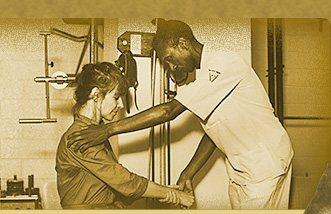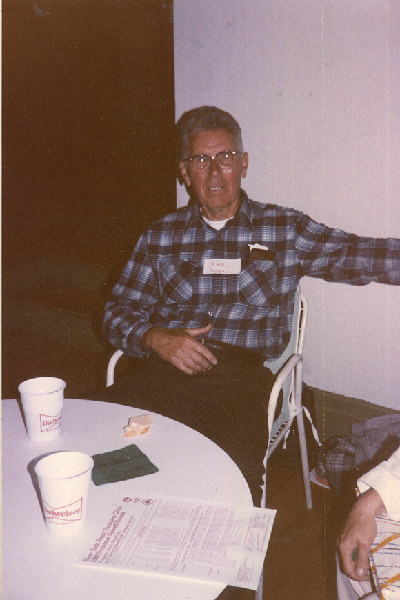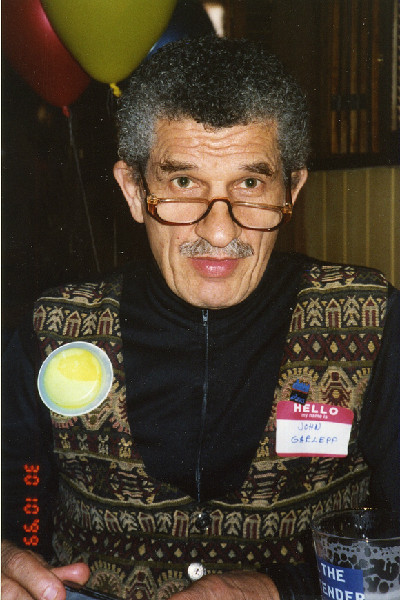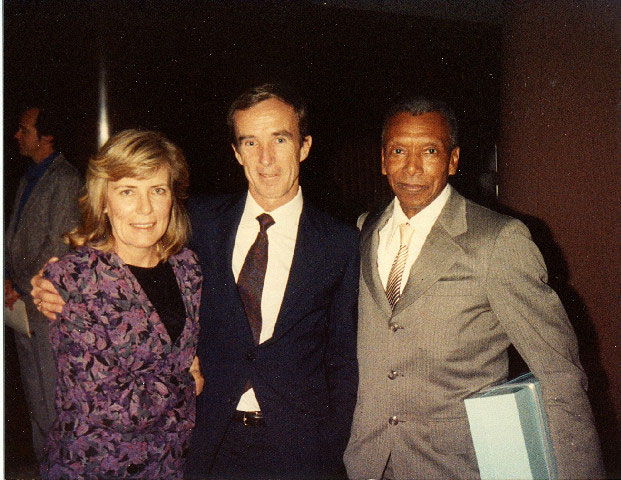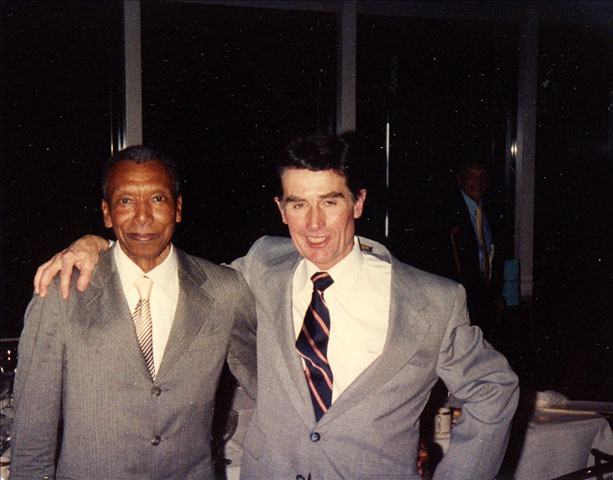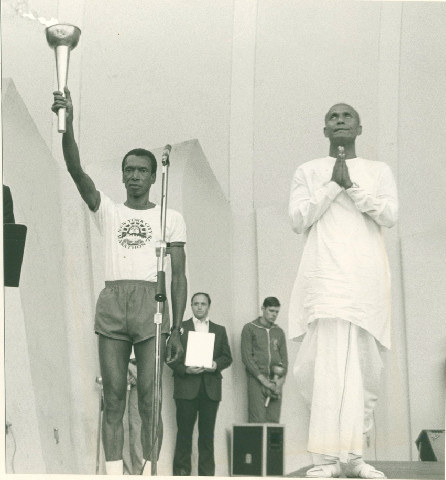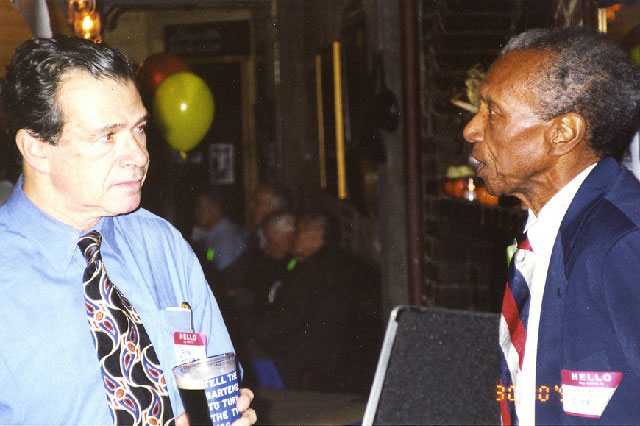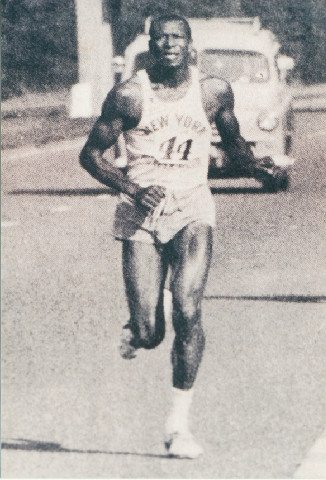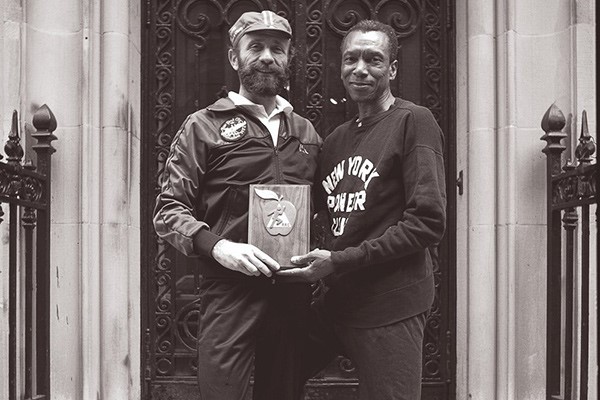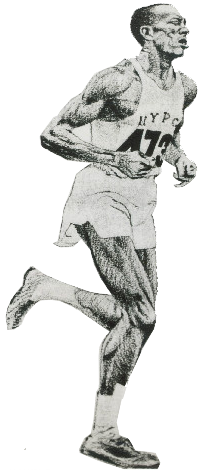
The Ted Corbitt Record
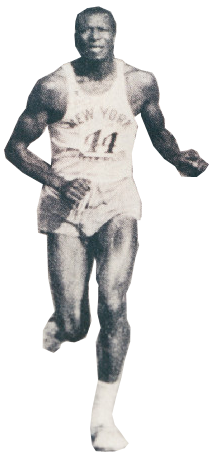
Olympian – Physical Therapist – Editor – Administrator – Educator - Father
“A Founding Father of Long Distance Running”
“The Father of Ultra- Marathon Running in the United States”
“An American Pioneer”
The Ted Corbitt Record Historical First
In 1952 became the first African American to represent U.S.A. in the Olympic Marathon.
The Olympics were held in Helsinki, Finland. He finished 44th in 2:51:09.
Ted Corbitt won the National U.S.A. Marathon Championship in 1954 at Yonkers, NY, and became the first African American to win a national marathon championship. Ted Corbitt would place 3rd in the U.S. Marathon Championship on four occasions (1952, 1955, 1957,1958).
Was first president of the New York Road Runners Club (NYRR) in 1958 and 1959. The club now stages the world’s largest marathon in the world - New York City Marathon. In 1958 the club started with 29 charter members and now has over 60,000 members.
Was the first editor (1958- 1978) of New York Runner the official publication of the New York Road Runners Club.
Was the first editor (1960) of the Road Runners Club of America’s national publication now called “Club Running”
Ted Corbitt was inducted in the inaugural National Distance Running Hall of Fame Class in 1998. The inaugural class included Joan Benoit Samuelson, Kathrine Switzer, Frank Shorter, and Bill Rodgers.
The Ted Corbitt Record World Records & World Bests
On four occasions Ted Corbitt completed 300 mile training weeks while working full-time. The most weekly mileage run was done September 1 -7, 1966. The totals were 312.5 miles or averaging 44.6 miles per day. This is believed to be a world best weekly running total for someone working full-time.
Was history’s most prolific marathon runner from May 1969 until February 1981. During this 12 year period, Ted Corbitt went from 132 to 196 marathons finished. He held the distinction of having run more marathons than anyone in the history of the sport.
Ted Corbitt ran two workouts per day for 13 consecutive years from January 1955 to July 24, 1968. This is believed to be a world best streak for two workouts per day.
Ted Corbitt highest monthly training miles were in July 1969 (1,002.5 Miles) and August 1969 (994 Miles) at age 50. This is believed to be a world best monthly running total for someone working full-time.
Ted Corbitt’s record mileage during a five day work week was 207.2 miles done July 9 -13, 1973. This averages to 41.4 miles per day. This is believed to be a world best weekly running total for someone working full-time.
Ted Corbitt on two occasions August 6, 1973 and October 11, 1973 totaled 50 training miles on a workday as a Physical Therapist. This is believed to be a world best daily running total for someone working full-time.
At age 82 in 2001, he walked 303 miles in 6 days setting an age group world record for a 6 day running event.
The Ted Corbitt Record American Records & American Bests
Ted Corbitt tied the record of Clarence DeMar for most consecutive Boston Marathons run under 3 hours, at 19 times, from 1954 to 1972.
On May 19, 1956, Ted Corbitt set an American Record for the marathon on a track running 2:42:25 in Philadelphia.
Ted Corbitt was ranked #2 in the world for Ultra-Marathon running throughout the 1960’s. Ultra-Marathons are races longer than the 26.2 mile marathon distance. On three occasions (1962 – 5:53:37, 1964 – 5:40:42, 1969 – 5:38:11), he set American road records at the London-to-Brighton 52.5 mile road race.
On October 15, 1966, he set an American Record for running 50 miles on the track. His time was 5:54:15. He also set American Records for 25 miles – 2:43:59, and 40 miles – 4:34:46 during this race held at Walton-on-Thames in England.
On November 28, 1968, Ted Corbitt at age 49 became the oldest American to win a U.S. national running title. He won the National 50 mile road championship in Poughkeepsie, New York in a time of 5:39:43.
On October 25 – 26, 1969, he set an American Record for running 100 miles on the track. His time was 13:33:06 at age 50. The race was held at Walton-on-Thames in England.
On October 25, 1970 at age 51, he set an American age group (50-54) record for 50 miles on the road of 5:34:01. The record still stands today 43 years later. It should be noted at age 50, during the 1969 London-to-Brighton race, his estimated 50 mile split time was a superior 5:22:06.
On November 3 – 4, 1973, he set an American Record for running 24 Hours on the track. His distance was 134.7 miles at age 54. The race was held at Walton-on-Thames in England.
The Ted Corbitt Record Historical Milestones
Ted Corbitt competed for the New York Pioneer Club (NYPC) his entire road running career starting in 1947. The New York Pioneer Club was co-founded in 1936 by Mr. Joseph Yancey an African American. The club was a model for racial integration during the Jim Crow era. Athletes represented all races, creeds and abilities.
During the 1950’s, Ted Corbitt was consistently among the top 5 American finishers at the Boston Marathon.
Ted Corbitt’s finishing position among Americans at Boston:
3rd Place: 1952, 1954, 1955, 1957, 1958*
4th Place: 1956
5th Place: 1959
*Unofficial finisher
His marathon personal record of 2:26:44 was set January 5, 1958 at the Shanahan Marathon in Philadelphia. At the time this was the third fastest time ever recorded by an American.
Was the third President of the Road Runners Club of America (RRCA) in 1960 & 1961. The RRCA is the oldest and largest national association of running clubs in the country with currently over 200,000 members.
Authored and published the booklet “Measuring Road Running Courses” in August 1964. This document initiated a program for accurate course measurement in the U.S.A. This ensured the legitimacy of the sport of long distance running with verifiable record keeping.
His lifetime total marathons and ultra-marathons completed were 223 from 1951 to 2003.
In 1966, he became the second runner in the history of the sport to finish 100 marathons.
Ted Corbitt – Physical Therapist Master Clinician and Teacher of Physical Therapy
Ted Corbitt worked for 44 years at the International Center for the Disabled starting in 1950. He continued to treat patients until 3 months before his passing at age 88.
International Center for the Disabled (ICD) – New York
| Staff Physical Therapist | 1949 – 1950 |
| Supervisor, Remedial Gymnasium | 1950 – 1956 |
| Assistant Chief of Physical Therapy | 1956 – 1968 |
| Chief & Director of Physical Therapy | 1968 - 1986 |
| Assistant Director of Physical Therapy | 1986 - 1994 |
He was one of the first African Americans to enter the Physical Therapy profession. He was a long time member of the American Physical Therapy Association and was active with the New York chapter in the 1950’s and 1960’s.
Ted Corbitt was recognized as a master clinician and teacher of Physical Therapy. He was considered an expert in Connective Tissue Massage, Deep Muscle Therapy, Proprioceptive Neuromuscular Facilitation (PNF) Techniques, and Progressive Resistance Exercises.
He studied with the following legends in field health and rehabilitation:
He studied Connective Tissue Massage from the originator of this technique Elizabeth Dicke during two trips to West Germany in 1956 and 1962.
He studied PNF stretching or Proprioceptive Neuromuscular Facilitation with Margaret Knott in 1960 at Boston University and with Dorothy Voss in 1972 at Northwestern University.
He studied with Josephine Rathbone a leader in the field of corrective (adaptive) physical education and the medical application of exercise for rehabilitation, which became the field of Physical Therapy.
He studied Neurophysiology: Rood Techniques in 1965 at the University of North Carolina. This technique was develop by Margaret Rood.
He studied with Lulu Sweigard a teacher of body balance and efficient movement. She developed an education method that stressed the inherent capacity of the nervous system to determine the most efficient neuromuscular coordination for each movement.
He studied with Marge Kapsos an originator of cross-fiber friction massage which is a full body massage designed to release toxins, spasms and joint pain.
He was an early advocate (1950’s) in the United States for applying acupuncture techniques in his practice and the use of weight training for athletes.
He taught for over 25 years at Columbia University, and several years at New York University. ICD had clinical education responsibilities for these other Greater New York area schools: Downstate Medical College, Hunter College, LaGuardia College, and Long Island University.
In 1960, Ted Corbitt co-authored a book “Hydrotherapy” a practical manual on the therapeutic use of water. This was the first modern comprehensive textbook on this important branch of physical therapy.
New York University: MA in Physical Therapy
Ted Corbitt and the Modern Marathon JUL 01, 2021
Ted Corbitt was the first Black American Olympic marathoner (Helsinki, 1952) and the first president of New York Road Runners. His many contributions—in leadership, technology, competition, training, and physical therapy—make him the single most effective individual in establishing the American marathon as a modern sport.
The Marathon in Mid-Century America
In the United States in the 1950s the marathon was seen as little more than an exhibition event, gaining widespread attention only once every four years at the Olympics. Marathon courses varied widely; even at the Olympics the marathon distance had not been standardized until 1924.
In the United States, local road race organizers often measured courses with automobile odometers,1 and inconsistencies in course calibration subjected records to dispute and dismissal.
Long-distance runners followed middle-distance training programs rather than specializing for the marathon. Marathon running came under the bureaucratic aegis of the Amateur Athletic Union (AAU), which denied celebrity to the event and denied resources to its practitioners.
Ted Corbitt’s Journey to the Marathon
Ted Corbitt (pictured above, right) grew up with running and segregation. Born in South Carolina in 1919, he ran two miles to and from elementary school as Black children were not provided buses. When he was 7 his family moved to Cincinnati, OH, where Corbitt competed in track races in junior and senior high school—yet as a member of the University of Cincinnati track team he was barred from some competitions because he was Black.
Corbitt moved to New York City in 1946 and in 1947 he joined the New York Pioneer Club (NYPC), a Harlem-based, racially integrated track club with an agenda of civil rights activism. After receiving a master’s degree in physical therapy in 1950 and while practicing at the International Center for the Disabled (ICD) as a staff physical therapist, Corbitt devoted his spare time to training for the marathon. He ran the Boston Marathon in 1951, placing 15th in 2:48:42.
Historian John Chodes describes this period as the “Dark Ages” of marathon running, when “little was known and less written about training.”2 With his knowledge of physiology and talent at distance running, Corbitt was ready to fill that void.
Marathoners as “Second-Class Athletes”
Corbitt and other distance runners faced many challenges. One was that American society of the 1950s disapproved of the individualistic long-distance runner, who ran along public streets no matter what the weather. Aldo Scandurra, later a president of NYRR, remembered that track runners looked down on long-distance practitioners: "Athletes regarded road runners as second-class athletes."3
Another challenge was that marathoners generally reached their performance peak in their late 20s or later, when most of them had to balance training with earning a living and often supporting a family. The athletics bureaucracy rarely supported or even encouraged marathon training. There were few publications; information about distance running was most often available only among those lucky enough to find a cohort such as the NYPC.
The low status of American distance runners became starkly apparent at the 1952 Helsinki Olympics, where Emil Zatopek of Czechoslovakia won the 5000 meters, 10000 meters, and the marathon in a world record time. The top American finisher, Victor Dyrgall, finished 13th; Corbitt (#999 in the photo below), who had made the team due to outstanding performances at the Boston and Yonkers marathons, placed 44th.

Corbitt documented his Olympic experience in The Physical Therapy Review,4 noting the separate residential facilities set up for the USSR and other Soviet bloc countries5 and commenting on the scheduling of the 1952 U.S. Olympic Trials just two weeks before the Games. “An additional few days or a week of rest and treatments would have made a big difference in the performances of some of the athletes—including several potential gold medalists,”6 he wrote. The American sport bureaucracy seemed to neglect the needs of its Olympians, while the Soviet bloc offered its athletes state support.
In the U.S., antagonism between the National Collegiate Athletic Association (NCAA) and the AAU discouraged collegians from running marathons. Runners on college teams, particularly if they were on track scholarships, had to get permission to compete for their schools in AAU events, and some were forbidden to enter any AAU events. AAU regulations undermined many club track teams and kept college track runners from long-distance racing and training.7
In any case, few American marathons even existed, and only Boston consistently offered top international competition. In 1954 the Boston Marathon had 148 starters, the lowest number since 1945.8 The Shanahan Catholic Club of Philadelphia began an important annual marathon in 1954, with Corbitt winning the inaugural race in 2:36:069 and setting his lifetime best of 2:26:44 there on January 5, 1958.
A New Organization for Distance Running
On February 22, 1958, H. Browning Ross, a 1948 Olympic steeplechaser, met with nine other runners at the Paramount Hotel in New York City10 to create the Road Runners Club of America (RRCA), an organization that would assert the rights of long-distance runners. The RRCA was modeled on the Road Runners Club of England11 but Ross had also seen the NYPC successfully challenge the AAU on matters of segregation and exclusivity and had been coached by Joe Yancey, the NYPC’s activist coach, during an AAU tour.
The RRCA encouraged the formation of local running clubs, and in June 1958 Corbitt became the first president of the Road Runners Club–New York Association (RRC–NYA), which evolved into NYRR. He went on to become the president of the RRCA in 1960-1961 and used the office to turn the marathon footrace into a modern sport.
Corbitt knew that the creation of a dedicated bureaucracy was the first step toward modernizing the marathon.12 Under his leadership, the RRCA continued the tradition of protest and mass action that had developed in Harlem and expanded under Joe Yancey, and over time, the RRCA infiltrated the AAU hierarchy. Eventually the AAU granted the RRC–NYA sanction to hold open races that any AAU-registered athlete could enter. Equality of opportunity is another characteristic of modern sport;13 now, there were more chances to compete and more athletes who were official competitors.
In New York City, the Metropolitan AAU finally accepted RRCA-sponsored events because Aldo Scandurra, a competitive marathoner, had become co-chairman of the Metropolitan AAU Long-Distance Running Committee.14 On September 14, 1964, the RRC–NYA became a member of the Metropolitan AAU.15
The Precursor of the New York City Marathon
On February 22, 1959, the RRC–NYA sponsored its first marathon, the Cherry Tree Marathon, at Macombs Dam Park in the Bronx; Ted Corbitt won in 2:38:57.
Corbitt strengthened the national long-distance running bureaucracy with a quarterly newsletter, which he largely wrote and entirely edited, published, and distributed. The publication codified the rules of road racing with articles such as “How to Measure Road Race Courses.”16 With equal conditions of competition, runners all over the country could compare performances and evaluate their own abilities.17
More than any other single factor, Ted Corbitt’s 30-page report detailing the various systems of course calibration18 established the marathon as a modern sport. The AAU Standards Committee, created in 1965, used Ted Corbitt's 1964 book, Measuring Road Racing Courses, for their guidelines.
“My initiating the accurate course measurement program in the USA is easily the most important thing that I did in the long distance running scene,”19 Corbitt said. His quantification of the marathon helped legitimize the event. The RRCA instituted the bicycle-wheel method of course calibration, raising the level of quantification for road racing courses all over the United States.20
Corbitt also provided information on training and racing for runners of all abilities as the editor of the Road Runners Club New York Association Newsletter, a post he held from 1958 to 1978.21
The First New York City Marathon
Marathon fields increased through the 1960s. Writing in The New York Times, Hal Higdon compared joggers to baseball fans; but, while the latter could never play in the World Series, the diligent joggers could reasonably aspire to the Boston Marathon. Having developed endurance more than speed, they entered the marathon for the satisfaction of finishing—and yet they were official entrants.22 The path to the “running boom” of the 1970s was opened.
The first New York City Marathon took place on September 13, 1970, on the roads of Central Park with 127 entrants and 55 finishers.
Six years later, having outgrown the park’s four-loop course and encouraged by ever-increasing fields nationwide, NYRR took the marathon to the five boroughs of New York City. Ted Corbitt’s course calibration guaranteed a legitimate record, attracting elite runners such as Bill Rodgers and Frank Shorter.
The 1976 New York City Marathon had over 2,000 entrants and 1,549 finishers. The exponentially increasing fields of the following years turned a local footrace into a spectacle that would attract the world’s attention and emulation. The 2019 TCS New York City Marathon, the largest marathon in history, had 53,640 finishers.

Ted Corbitt completed his final ultramarathon, 68.7 miles in 24 hours, in 2003 at age 82. In 2007, in his acceptance speech of the Lifetime Achievement Award at the Runner’s World Heroes of Running Ceremony, he said, “In addition to training extensive mileage, I spent years doing administrative stuff in the background, to help our sport survive and grow.”23 He passed away at age 88 on December 12, 2007.
Learn more about Corbitt in the Ted Corbitt Archives, an invaluable resource for any running historian. Learn more about the New York Pioneer Club in our blog post from earlier this year.
Endnotes
- John Chodes, Corbitt: The Story of Ted Corbitt, Long-Distance Runner (Los Altos, Calif.: Tafnews Press, 1974), 73.
2. Chodes, Corbitt, 5.
3. Aldo Scandurra, “History of Long Distance and Road Racing,” Long Island Running News 1, May 1981, 9.
4. Ted Corbitt, “The 1952 Olympic Games,” The Physical Therapy Review. Vol. 32, No. 12 December, 1952 pp. 650-652. Ted Corbitt Archives, accessed 14 June 2021.
5. Ibid., 650.
6. Ibid., 651.
7. Congress, Senate, Committee on Commerce, NCAA-AAU dispute: Hearing before the Committee on Commerce, 89th Cong., 1st Sess., 16-27 August 1965, iii-iv, 604.
8. David E. Martin and Roger W.H. Gynn, The Marathon Footrace: Performers and Performances (Springfield, Illinois: Charles C. Thomas, 1979), 172.
9. Chodes, Corbitt, 150.
10. Gar Williams and Jeff Darman, "History of the Road Runners Club of America," in The Road Runners Club of America Handbook: A Guide to Club and Race Administration, edited by Gar Williams (Published by the Road Runners Club of America, 1978), 208-218.
11. H. Browning Ross, Editor of Long Distance Log and founder of the Road Runners Club of America, interview by author, 16 January 1992, Woodbury, New Jersey, tape recording.
12. Allen Guttmann, From Ritual to Record: The Nature of Modern Sports (New York: Columbia University Press, 1978), 21, 45. In From Ritual to Record, Guttmann describes ancient sport as originating in “sacred festivals,” and the rules that bound the athletes were often religious in nature and rigid in practice. But modern sport is secular and characterized by a “bureaucracy of functional roles.” In addition to secularization and bureaucratization, Guttmann noted other characteristics of modern sport: equality of opportunity to compete (26), specialization for a particular event (39), rationalization of the conditions of competition (42), quantification (47), and records (51).
13. Ibid., 35.
14. Amateur Athletic Union, Minutes of the Annual Meeting of the Amateur Athletic Union 1962, 25.
15. Ted Corbitt, “History of the Road Runners Club: The RRC, New York Association,” Road Runners Club New York Association Newsletter, 22 Fall 1964, 1.
16. Ted Corbitt, “How to Measure Road Race Courses” RRC Footnotes, October 1, 1962. Ted Corbitt Archives, accessed 14 June 2021.
17. Guttmann, From Ritual to Record, 42.
18. Chodes, Corbitt, 147-49.
19. Ted Corbitt Archives, accessed 10 June 2021.
20. Williams and Darman, "History of the Road Runners Club of America," 211.
21. Ted Corbitt Archives, accessed 10 June 2021.
22. Hal Higdon, "Jogging is an In Sport," New York Times Magazine, 14 April 1968, 36-52.
23. Ted Corbitt Archives, accessed 18 June 2021.
Author: Pamela Cooper Chenkin
Pamela Cooper Chenkin is the author of The American Marathon (Syracuse University Press).
